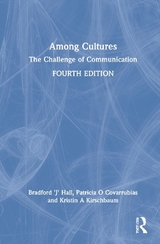
Among Cultures
Routledge (Verlag)
978-1-138-65781-6 (ISBN)
- Titel erscheint in neuer Auflage
- Artikel merken
Among Cultures: The Challenge of Communication, Third Edition explores intercultural communication and the relationship between communication and culture, using narrative as a common and compelling thread for studying intercultural interactions. Anchored in the position that people make sense of their worlds through choosing and telling narratives to themselves and others, this text is replete with narratives and stories. Chapters address key aspects of intercultural communication, including verbal and nonverbal communication; stereotypes and bias; identity; conflict; diversity; and ethics. Using an interpretive approach to intercultural communication, the text helps students understand that although a person may appear different, his/her common sense is quite reasonable within a particular interpretive context. Resources are included to help students understand and explain the reasonableness of other cultural systems.
The text includes activities for students to complete while reading, including self-assessments and nonverbal self-knowledge tests. Reflection questions within and at the end of each chapter promote thinking and discussion on each topic. With its unique approach to studying intercultural communication via real-life narratives, this text facilitates a deep understanding of the cultural aspects of communication. In providing the narratives of others, it encourages students to tell their own stories and build a strong foundation for communicating across cultures.
New to the Third Edition:
New chapter—"What Role Does Culture Play in Contemporary Contexts?"—explores intercultural communication as it relates to the environment, health, and technology.
New sections on identity, silence, and terms of address as important communicative practices in intercultural settings.
Updated sections on honorifics, key terms, social dramas and the golden approaches to ethics.
Bradford J. Hall is Head of the Department of Languages, Philosophy, and Communication Studies at Utah State University. He teaches in the areas of intercultural communication and communication theory, focusing on the link between our talk, thoughts, and actions. His research deals with issues of culture, identity, membership, conflict, and everyday conversation. Patricia O. Covarrubias is Associate Professor in the Department of Communication and Journalism at the University of New Mexico where she teaches cultural and intercultural communication, cultural discourse analysis, global metaphors, qualitative research methods, and the ethnography of communication. Her research has been dedicated to understanding the linkages among culture, communication, and peoples’ unique ways of life. Kristin A. Kirschbaum is Associate Professor at East Carolina University, and has taught courses in health communication, intercultural communication, organizational health communication, interpersonal communication, and communication theory. Her research includes measures of communication in physician populations with structured research protocols aimed to increase collaboration and medical communication among physicians.
Preface
Chapter 1: What is Meant by Intercultural Communication?
Culture
System
Historically Shared
Symbolic Resources
Make our World Meaningful
Selection
Organization
Evaluation
Communication
Interdependent
Situational
Intercultural Communication
Intercultural Communication as a Field of Study
Hazards of Studying Intercultural Communication
Oversimplification
Overgeneralization
Exaggeration
Benefits of Studying Intercultural Communication
Personal Empowerment
Freedom from Ignorance
Productive Relationships
Summary
Reflection Questions
Activities
Chapter 2: What is the Relationship between Communication and Culture?
Manifestations of Culture
Worldviews
Individualism/Collectivism
Ascript ion/Achievement
Egalitarian/Hierarchical
Good/Evil
Mastery/Adaptive
Social lubricant/Information
High context/Low context
Polychronic/Monochronic
Final Thoughts on Worldviews
Values
Norms
Two Perspectives on the Culture Communication Connection
Monolithic Force
Reflexive Force
Sense Making
Situational
Summary
Reflection Questions
Activities
Chapter 3: How Can We Learn About Our Own and Others' Cultures?
The Learning Process
Need
Precedent
The Etic/Emic Distinction
Hymes SPEAKING Framework: An Etic Grid
Scenes
Participants
Ends
Acts
Keys
Instrumentalities
Norms
Genres
Narratives
Narrative Teaching Functions
The way the world works
Our place in the world
How to act in the world
How to evaluate what goes on in the world
Interpreting Narratives
Ritual
(Mis)impressions about the Nature of Rituals
Just the same thing over and over again
Outdated, hypocritical and meaningless
Reserved for specialized settings
Engaged in by those less sophisticated than I
Recognizing Rituals Around Us
The Worth of Rituals
Social Dramas
Key Terms
Summary
Reflection Questions
Activities
Chapter 4: How is Culture Related to Our Identities?
Identity
Expectations Related to Ourselves and Others
Role Expectations
Language Expectations
Interplay between Similarities and Differences
Personal, Relational and Communal Levels of Identity
Personal
Relational
Communal
Communication's Relationship to Identity
Reflective
Constitutive
Pathways to Identity
Avowal
Ascription
Reactive
Proactive
Summary
Reflection Questions
Activities
Chapter 5: Where Can We Look to Explain Verbal Misunderstandings?
Verbal Communication and Context
Contextual Frames
Frames and Expected Forms of Communication
Frames Evoking and Assuming Informal Rules
Frames Evoking and Assuming Identities
Verbal Communication: Structure And Content
Quality
Idioms
Quantity
Silence
Elaborated & Restricted Codes
Relevance
Forms of Address
Questions & Answers
Manner
Code-Switching
Gratuitous Concurrence
Terms of Address
Pronouns
Honorifics
Face Considerations
Direct/Indirect Communication
Language and Thought
Sapir-Whorf Hypothesis
Summary
Reflection Questions
Activities
Chapter 6: Where Can We Look to Explain Nonverbal Misunderstandings?
Roles of Nonverbal Communication
Repetition
Contradiction
Substitution
Accentuation
Complementary
Regulation
Forms of Nonverbal Communication
Kinesics
Facial Expressions
Body Movements
Five Functions
Emblems
Illustrators
Affect displays
Regulators
Adaptors
Proxemics
Space
Touch
Paralanguage
Silence
Silence and sociocultural identities
Silence and social relationships
Silence and conflict
Other Forms of Nonverbal Communication
Living environment
Clothes
Food
Smell
Time
Intercultural Listening and Nonverbal Communication
Summary
Reflection Questions
Activities
Answers to Face Test and to Intercultural Kinesics Cues Quiz
Chapter 7: Why Do So Many People Get Treated Poorly?
Stereotyping
Categorization
Fundamental Attribution Error
Five Points of Variance
Direction
Intensity
Specificity
Consensus
Accuracy
Ethnocentrism
Concern/Indifference
Involvement/Avoidance
Enjoyment/Intolerance
Prejudice
Forms of Prejudice
Blatant
Conceit
Symbolic
Tokenism
Arms-length
Rationalizing Narratives of Prejudice
Morally better
Personally afflicted
Social pressure
Their turf
System Abuse
Functions of Prejudice
Utilitarian
Social status
Ego-defensive
Value-expressive
Easy knowledge
Summary
Reflection Questions
Activities
Chapter 8: How Can We Manage Conflict in Intercultural Settings?
Cultural Approaches to Conflict
Avoiding
Accommodating
Competing
Compromising
Collaborating
Types of Intercultural Conflict
Object conflicts
Relationship conflicts
Priority conflicts
Intergroup Conflict
Group Membership and Communication
Group Membership and Conflict
Ingroup bias
Fears surrounding intergroup communication
Origins of Intergroup Conflict
Histories
Dividing up the pie: competition and power
Strategies for Managing Intercultural and Intergroup Conflict
Appropriate Conditions for Successful Contact
Joint goals
Supportive social climate
Equal status
Variety of contexts
Desire for contact
Recognizing Reasonableness
Factoring in Face
One Final Point to Ponder: Forgiveness
Summary
Reflection Questions
Activities
Chapter 9: How Can We Succeed in Our Intercultural Travels?
Hierarchy of Human Needs
Acculturation
U-curve Model
Honeymoon
Crisis
Recovery
Adjustment
The Hero's Journey: Osland's Model of Working Abroad
Call to adventure
In the belly of the whale
The magical friend
Road of trials (paradoxes)
Ultimate boon and return
Surprise and Sense-making Model
Change
Contrast
Surprise
Sense-making
Attribute meaning
Update expectations
Select behavioral approach
Kim's Adaptation Model
Personal communication
Predisposition
Environment
Social communication
Intercultural transformation
Returning Home: Readapting to Our Own Cultural Community
Reverse Culture Shock
Change in Self and Others
Unrealistic Expectations
Lack of Appreciation in Home Community
Final Thoughts on Cultural Transactions
Summary
Reflection Questions
Chapter 10: How does Culture Impact Applied Contexts?
Environmental Communication
Environmental Communication as a Symbolic Resource for Making Sense of
our World.
Environmental Communication as a Place of Conflict
Environmental Communication as Gendered
Environmental Communication in the Context of Ecotourism
Environmental communication as Inherently Cultural
Healthcare and Intercultural Communication
Differing Cultural Expectations
Specific Applications of Cultural Communication in Healthcare
Sensitivity to Cultural Communication Considerations in Healthcare
Verbal and Nonverbal Communication in Healthcare
Other Cultural Considerations and Applications of Communication
Public Health
Holistic Approaches
Organizational Leadership and Intercultural Communication
Social Scientific Approach: Dimensions of Intercultural Leadership Success
Interpretive Approach: Leadership and Sense-Making in Intercultural
Settings
Summary
Reflection Questions
Activities
Chapter 11: What Diversity Exists in the Study of Intercultural Communication?
Major Perspectives in Intercultural Communication
Interpretive Perspective
Critical Perspective
Social Scientific Perspective
Popular Culture
Characteristics of Popular Culture
Easily Accessed
Commercial
Tells Us What We Believe and What We Should Believe
Tells Us Who We Are and Who We Should Be
Popular Culture Artifacts
Icons: Real and Imagined
Celebrities: Real and Imagined
Critical Perspectives of Popular Culture and the Media
Social Scientific Perspectives of Popular Culture and the Media
Impact of the Media on Culture
Impact of Culture on the Media
Culture as an Intervening Variable
Summary
Reflection Questions
Activities
Chapter 12: Can Judgments of Right and Wrong Be Made when Dealing with Other Cultures?
Ethics
General Perspective
Six Golden Approaches
Golden Purse
Golden Mean
Golden Public
Golden Law
Golden Consequence
Golden Rule
Ethics and Communication
Constraint
Empowerment
Ethics and Culture
Universalism
Relativism
Critique
Efforts to Find Universal Ethics that Acknowledge the Relativistic Nature of Cultures
Ethical Principles for Intercultural Relations
Effort to Understand
Teachable Attitude
Mutual Legitimacy
Dialogue
Considering Context
Peaceful Disagreement
Nonviolence
Truth/Openness
Loving Relationships
Intercultural Marriage Microcosm
Nature of love
Summary
Reflection Questions
Activities
Activities
Notes
| Erscheinungsdatum | 09.10.2017 |
|---|---|
| Zusatzinfo | 7 Tables, black and white |
| Verlagsort | London |
| Sprache | englisch |
| Maße | 156 x 234 mm |
| Gewicht | 771 g |
| Themenwelt | Geisteswissenschaften ► Geschichte |
| Geisteswissenschaften ► Sprach- / Literaturwissenschaft ► Sprachwissenschaft | |
| Sozialwissenschaften ► Kommunikation / Medien ► Kommunikationswissenschaft | |
| Sozialwissenschaften ► Soziologie | |
| ISBN-10 | 1-138-65781-6 / 1138657816 |
| ISBN-13 | 978-1-138-65781-6 / 9781138657816 |
| Zustand | Neuware |
| Informationen gemäß Produktsicherheitsverordnung (GPSR) | |
| Haben Sie eine Frage zum Produkt? |
aus dem Bereich



